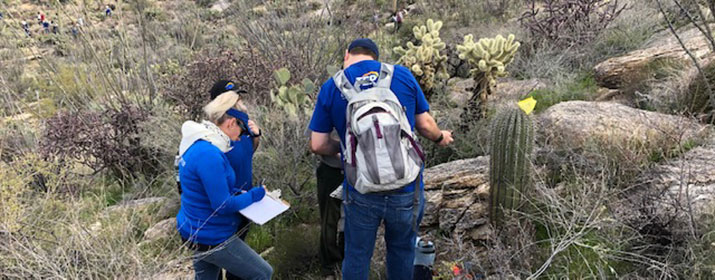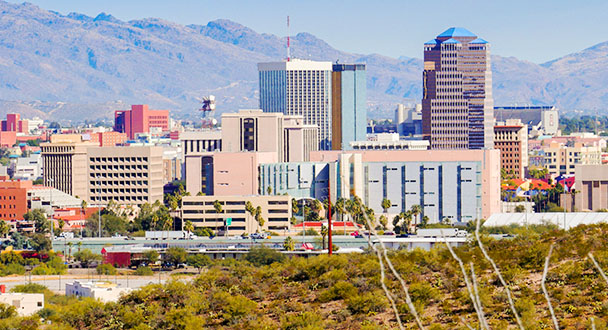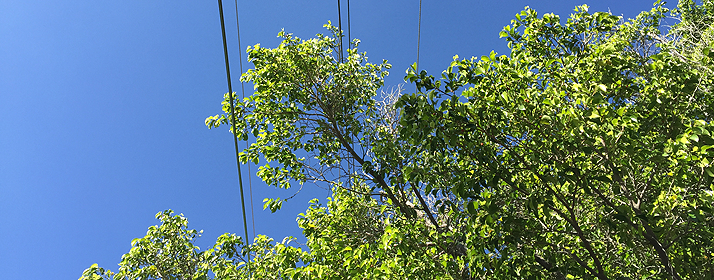
When public spaces reopen, people will gather at Saguaro National Park East’s Visitor Center to learn about pollinator gardens, to celebrate the yearly cholla bud harvest and to appreciate Native American weaving displays.
And they’ll be able to do it comfortably under a large shade structure, thanks to recent renovations to the center, which was built in the 1930s. “There really wasn’t a comfortable space for interpretive projects, so this will allow us to really strengthen the educational component of the park,” said Fred Stula, Executive Director of the park’s nonprofit fundraising arm, the Friends of Saguaro National Park.
Because of our commitment to the environment, Tucson Electric Power last year was pleased to donate $25,000 to complete the shaded patio, which will accommodate about 150 visitors a day.
This project was the latest collaboration in TEP’s decades-long relationship with the group and part of a larger focus on sustainability. In addition to the Friends, TEP supports the Arizona-Sonoran Desert Museum, Sonoran Institute, Arizona Trail Association, Sky Island Alliance, The Nature Conservancy and many other environmental groups. Our company even helped create the very first Tucson Earth Day Festival in 1995, and we have been an active participant ever since.
In another recent project this spring, two dozen employees from TEP’s Land Resources Department put aside their maps, charts, plats and permits to walk among desert cactus. They peered into clusters of cholla and peeped under mesquite trees in the Park, searching for saguaros of all sizes. It took focus: Even at 10 years of age, the cacti can be a mere three inches tall.
The team was participating in the 2020 Saguaro Census count, a massive undertaking that happens each decade at the park.
“It’s how we keep track of the health of our saguaros,” said Don Swann, a wildlife biologist for the National Park Service. “They live a long time – longer than we do – and this count helps us understand how the population is doing.”
Young saguaros are particularly vulnerable because they are not big enough to store water that can sustain them in the high desert temperatures. An extended drought, as our region has experienced, can have a significant impact on the population.
The count relies heavily on volunteers, like TEP’s Shannon Breslin and her team, to comb plots of desert. The Manager of Land Resources served for six years as a board member for the Friends of Saguaro National Park – one of a long string of TEP employees to serve in that role.
She had been looking for a way to bring her whole team together, despite their varied responsibilities in environmental planning, transmission patrol, vegetation management and land rights. “It was a unique opportunity to go out there and do some team building that was an extension of our work here, while also giving back to the community and supporting the biologists who manage this incredible resource.”
Brian Pugh, a TEP Environmental Planner, also enjoyed the experience. “The part that impressed everyone is that the work we did will be used by scientists decades from now. It gave us all a lot of enthusiasm to know we were part of something that would go on through time.”
Exploring the saguaro forests was further inspiration for the work he does, he said, which is to preserve natural resources while working to improve the resiliency of the electrical grid.
Swann said he appreciates TEP’s longstanding relationship with the park and the Friends. “The census is a big community effort and we are thrilled to have corporate support.”
And there was even a bit of good news. While the count was put on hold because of the response to the coronavirus pandemic, some preliminary findings were promising: Despite 20 years of very little new growth in response to the drought, some newly established saguaros were found in some parts of the park. More will be known after the saguaro census resumes this fall.
Watch a video about TEP’s work with nonprofits, including the Friends of Saguaro National Park.






